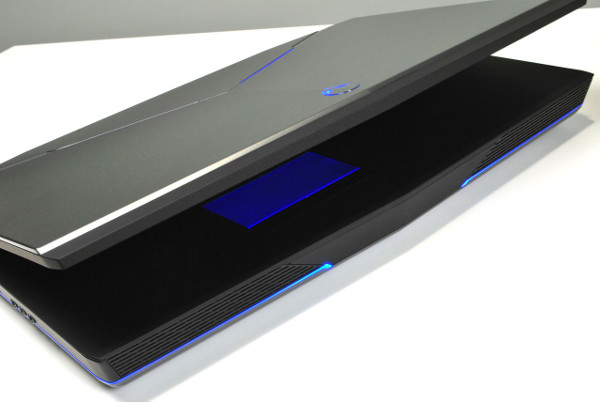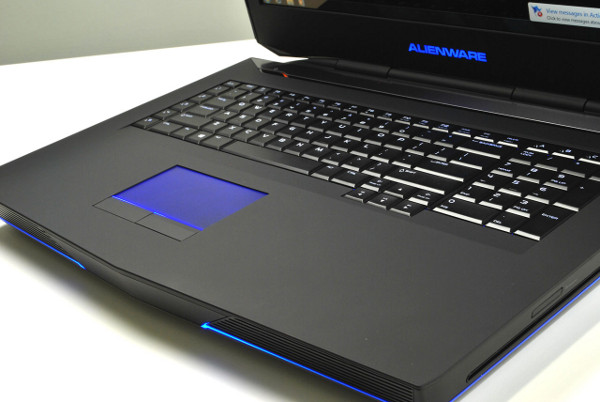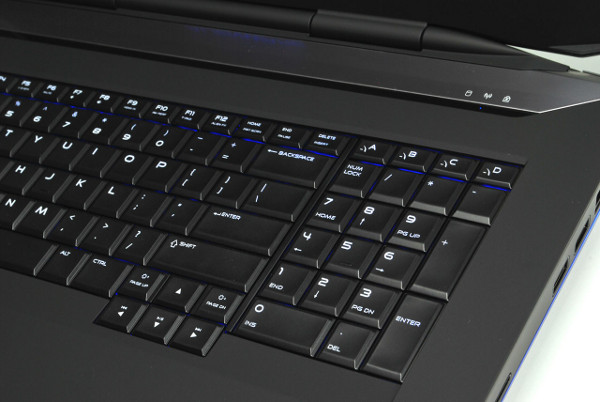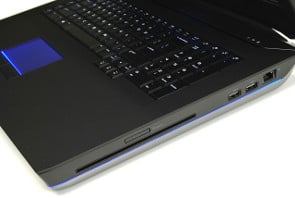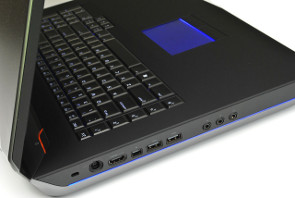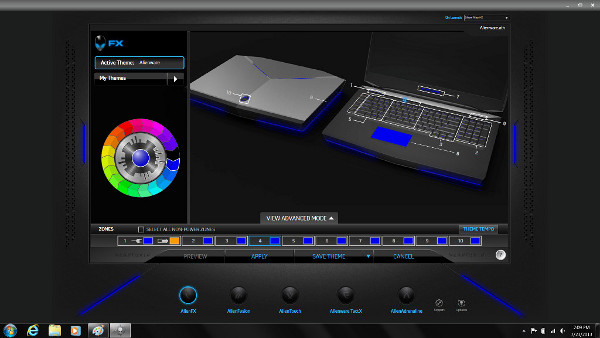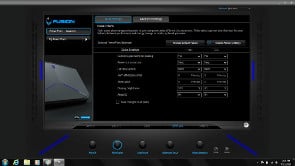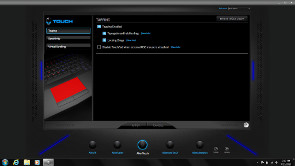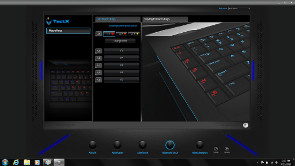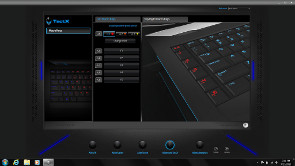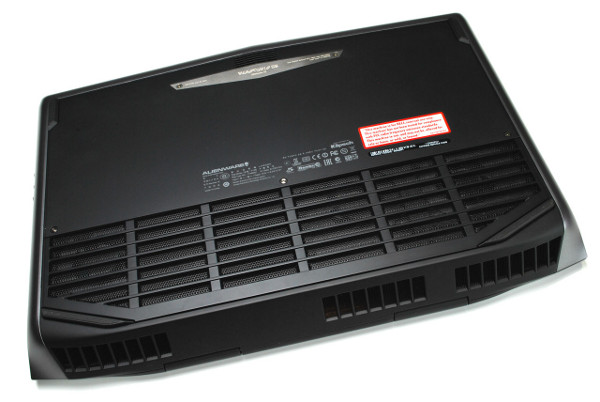Alienware 18 Notebook: Haswell, GeForce GTX 780M
Design & Layout
One of the most notable features of this Alienware rig compared to previous versions, apart from the obvious generational component upgrades, is a sweeping redesign of the look of the chassis.
Let’s begin around back; although the exhaust grills are the same, the power port has been moved from the back to the left side of the machine. Those familiar “headlights” at the front of Alienware notebooks have been replaced on the Alienware 18 with a more subtle and simple horizontal grill.
The sides remain fairly similar to previous designs. One side has the power port; a lock; HDMI port; DisplayPort; two USB ports; and mic, headphone, and headset jacks. The other has a slot-loading ODD, memory card slot (MMC/SD/MS/Pro), two more USB 2.0 ports, and a LAN port. The top part of the clamshell keeps the Alienware logo in the same spot but adds a v-shaped LED lighting design.
The most dramatic changes appear on the keyboard and touchpad area, though. The touchpad itself is no longer a matte black deal ringed in LED light; instead, the whole pad glows blue, with two black mouse buttons underneath. This edition also ditched the slightly angled front edge of the touchpad area that made resting one’s wrist on the machine for extended periods of time more comfortable. The new version looks sharper in that regard, but that’s one area where you definitely want to prioritize comfort over looks.
Dell really tidied up the keyboard area, stripping away all the extra white lettering and markings on the keys in favor of translucent digits and numerals that glow blue. Gone, too, are the media control bar and alien writing that used to reside at the top right of the keyboard area as well as the Alienware logo next to it. Instead, there’s really nothing there except for a smooth brushed-metal band above a rubberized finish. All of the controls, including a numpad, have been moved to the main keyboard area; it’s a much-improved look, although we found ourselves constantly hunting for the media buttons. The keys themselves, which seem a bit slimmer than those on earlier Alienware rigs, have a slight indentation to them to give you a little tactile help.
One final new touch is the power button, which is a physical button over on the top left of the laptop’s body. It’s slim and chrome, with a thin blue band of LED light along its top edge.
The included Alienware Command Center software is now at version 3.0, although it’s fairly similar to its predecessors. You can change the color scheme of 10 different “zones”, such as multiple sections of the keyboard, the touchpad, and so on, to a variety of different lighting colors. You can also set the colors to morph from one to another or pulsate.
AlienFusion is the area in which you can customize power plans that affect essentially every individual component of the system, and you can adjust the touchpad sensitivity, tap functions, and scrolling options in the AlienTouch area. AlienAdrenaline is back as well, and it allows you to create optimized game modes for your favorite titles and also enables performance monitoring so you can be sure to gauge how well your system is doing and if it might need some adjusting.
There’s a new area in Alienware Command Center 3.0 called Alienware TactX that lets you program the macro keys, of which there are 10 total--six on the left side of the keyboard running vertically, and four on the upper right in a horizontal line. You can change their color, assign a keystroke or a macro to them, and generally assign them any functions you wish. You can create up to three distinct profiles, too.
The pre-installed Alienware Audio tool lets you, among other things, toggle between stereo, quadraphonic, and 5.1 speaker configurations, and the difference having those options makes is huge. It’s quite simple to select your preferred setup for whatever you might be doing--watching YouTube videos, gaming, watching TV or movies, and so on.
Regardless of the setting though, the bass response is lacking, and we felt that the dynamic range in general was rather limited, which we could hear particularly at higher volumes. Much of the midrange was acceptable, but higher pitches sounded canny. This is nothing terribly surprising, as most notebook audio is lacking compared to even inexpensive standalone speakers, but the ability to optimize what we’re listening to by adjusting the speaker setup on the fly is a nice touch. It’s also worth noting that we didn’t detect much at all in the way of distortion.
Let’s begin around back; although the exhaust grills are the same, the power port has been moved from the back to the left side of the machine. Those familiar “headlights” at the front of Alienware notebooks have been replaced on the Alienware 18 with a more subtle and simple horizontal grill.
The sides remain fairly similar to previous designs. One side has the power port; a lock; HDMI port; DisplayPort; two USB ports; and mic, headphone, and headset jacks. The other has a slot-loading ODD, memory card slot (MMC/SD/MS/Pro), two more USB 2.0 ports, and a LAN port. The top part of the clamshell keeps the Alienware logo in the same spot but adds a v-shaped LED lighting design.
The most dramatic changes appear on the keyboard and touchpad area, though. The touchpad itself is no longer a matte black deal ringed in LED light; instead, the whole pad glows blue, with two black mouse buttons underneath. This edition also ditched the slightly angled front edge of the touchpad area that made resting one’s wrist on the machine for extended periods of time more comfortable. The new version looks sharper in that regard, but that’s one area where you definitely want to prioritize comfort over looks.
Dell really tidied up the keyboard area, stripping away all the extra white lettering and markings on the keys in favor of translucent digits and numerals that glow blue. Gone, too, are the media control bar and alien writing that used to reside at the top right of the keyboard area as well as the Alienware logo next to it. Instead, there’s really nothing there except for a smooth brushed-metal band above a rubberized finish. All of the controls, including a numpad, have been moved to the main keyboard area; it’s a much-improved look, although we found ourselves constantly hunting for the media buttons. The keys themselves, which seem a bit slimmer than those on earlier Alienware rigs, have a slight indentation to them to give you a little tactile help.
One final new touch is the power button, which is a physical button over on the top left of the laptop’s body. It’s slim and chrome, with a thin blue band of LED light along its top edge.
The included Alienware Command Center software is now at version 3.0, although it’s fairly similar to its predecessors. You can change the color scheme of 10 different “zones”, such as multiple sections of the keyboard, the touchpad, and so on, to a variety of different lighting colors. You can also set the colors to morph from one to another or pulsate.
AlienFusion is the area in which you can customize power plans that affect essentially every individual component of the system, and you can adjust the touchpad sensitivity, tap functions, and scrolling options in the AlienTouch area. AlienAdrenaline is back as well, and it allows you to create optimized game modes for your favorite titles and also enables performance monitoring so you can be sure to gauge how well your system is doing and if it might need some adjusting.
There’s a new area in Alienware Command Center 3.0 called Alienware TactX that lets you program the macro keys, of which there are 10 total--six on the left side of the keyboard running vertically, and four on the upper right in a horizontal line. You can change their color, assign a keystroke or a macro to them, and generally assign them any functions you wish. You can create up to three distinct profiles, too.
The pre-installed Alienware Audio tool lets you, among other things, toggle between stereo, quadraphonic, and 5.1 speaker configurations, and the difference having those options makes is huge. It’s quite simple to select your preferred setup for whatever you might be doing--watching YouTube videos, gaming, watching TV or movies, and so on.
Regardless of the setting though, the bass response is lacking, and we felt that the dynamic range in general was rather limited, which we could hear particularly at higher volumes. Much of the midrange was acceptable, but higher pitches sounded canny. This is nothing terribly surprising, as most notebook audio is lacking compared to even inexpensive standalone speakers, but the ability to optimize what we’re listening to by adjusting the speaker setup on the fly is a nice touch. It’s also worth noting that we didn’t detect much at all in the way of distortion.

